Attached files
| file | filename |
|---|---|
| 8-K - FORM 8-K - MOSAIC CO | d658569d8k.htm |
 Market Outlook
Picking Up the Knife
(and starting a fight?)
Mosaic AgCollege
Orlando, FL
January 14, 2014
Michael R. Rahm
Vice President
Market and Strategic Analysis
Andy Jung
Director
Market and Strategic Analysis
Exhibit 99.1 |
 Safe
Harbor Statement 2
This presentation contains forward-looking statements within the meaning of the Private Securities
Litigation Reform Act of 1995. Such statements include, but are not limited to,
statements about the proposed acquisition of the Florida phosphate assets and certain related liabilities of CF
Industries, Inc. (“CF”) and the ammonia supply agreements with CF; the benefits of the
transactions with CF; future strategic plans and other statements about future financial and
operating results. Such statements are based upon the current beliefs and expectations of The Mosaic
Company's management and are subject to significant risks and uncertainties. These risks and
uncertainties include but are not limited to risks and uncertainties arising from the
possibility that the closing of the proposed phosphate asset acquisition may be delayed or may not occur, including
delays arising from any inability to obtain governmental approvals of the transaction on the proposed
terms and schedule and the ability to satisfy other closing conditions; difficulties with
realization of the benefits of the transactions with CF, including the risks that the acquired assets may not
be integrated successfully or that the cost or capital savings from the transactions may not be fully
realized or may take longer to realize than expected, regulatory agencies might not take, or
might delay, actions with respect to permitting or regulatory enforcement matters that are
necessary for Mosaic to fully realize the benefits of the transactions including replacement of
CF’s escrowed financial assurance funds, or the price of natural gas or ammonia changes to
a level at which the natural gas based pricing under one of the long term ammonia supply agreements with
CF becomes disadvantageous to Mosaic; customer defaults; the effects of our decisions to exit business
operations or locations; the predictability and volatility of, and customer expectations about,
agriculture, fertilizer, raw material, energy and transportation markets that are subject to
competitive and other pressures and economic and credit market conditions; the level of inventories in
the distribution channels for crop nutrients; changes in foreign currency and exchange rates;
international trade risks; changes in government policy; changes in environmental and other
governmental regulation, including greenhouse gas regulation, implementation of numeric water quality
standards for the discharge of nutrients into Florida waterways or possible efforts to reduce
the flow of excess nutrients into the Mississippi River basin or the Gulf of Mexico; further
developments in judicial or administrative proceedings, or complaints that Mosaic's operations are
adversely impacting nearby farms, business operations or properties; difficulties or delays in
receiving, increased costs of or challenges to necessary governmental permits or approvals or
increased financial assurance requirements; resolution of global tax audit activity; the effectiveness
of the Company's processes for managing its strategic priorities; the ability of the Northern
Promise joint venture among Mosaic, Ma'aden and SABIC to obtain project financing in acceptable
amounts and upon acceptable terms, the future success of current plans for the joint venture and any
future changes in those plans; adverse weather conditions affecting operations in Central
Florida or the Mississippi River basin or the Gulf Coast of the United States, and including
potential hurricanes, excess rainfall or drought; actual costs of various items differing from
management's current estimates, including, among others, asset retirement, environmental
remediation, reclamation or other environmental regulation, Canadian resources taxes and royalties, or the
liabilities Mosaic is assuming in the proposed phosphate assets acquisition; brine inflows at Mosaic's
Esterhazy, Saskatchewan, potash mine or other potash shaft mines; other accidents and
disruptions involving Mosaic's operations, including potential mine fires, floods, explosions, seismic
events or releases of hazardous or volatile chemicals, as well as other risks and uncertainties
reported from time to time in The Mosaic Company's reports filed with the Securities and
Exchange Commission. Actual results may differ from those set forth in the forward-looking statements.
|
 Welcome to AgCollege
We value our “relationship”
(a short story)
We greatly appreciate your business and want
to see us both succeed by delivering
innovative solutions & value to our customers
Introducing Andy Jung
An explanation of the title of our presentation
Preliminaries |
 An explanation of the
title of our presentation 4
MOP
2011 Peak: $560
2013 Trough: $310
Change: -45%
Current: $320
Change: +3%
Urea
2012 Peak: $740
2013 Trough: $280
Change: -62%
Current: $390
Change: +39%
DAP
2011 Peak: $660
2013 Trough: $340
Change: -48%
Current: $439
Change: +29%
Let it hit the floor and pick it up
100
200
300
400
500
600
700
05
06
07
08
09
10
11
12
13
14
$ Ton/ne
Plant Nutrient Prices
Urea -
fob NOLA
DAP -
fob Tampa
MOP -
c&f Brazil
Source: Fertecon, CRU, FMB and ICIS |
 Agricultural Situation and Outlook
Phosphate Situation and Outlook
Potash Situation and Outlook
Factors to Watch and Handicap
Q&A
Agenda
Mike
Andy
Mike
Andy |
 Agricultural Situation and Outlook |
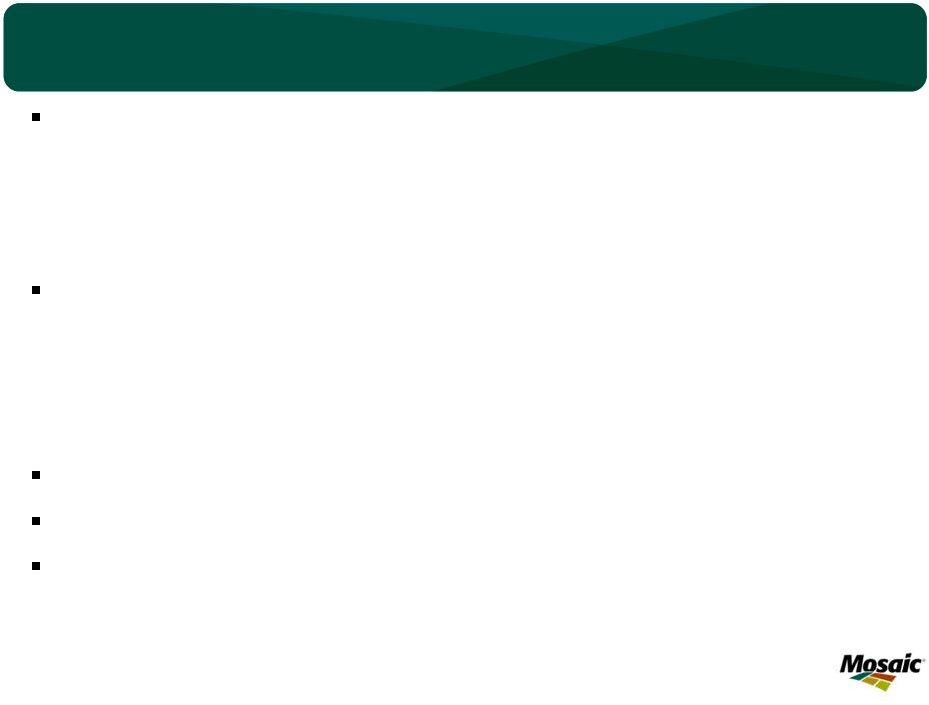 Key
Features and Take Aways Record-smashing global harvest and large stock
build in 2013/14 –
Record harvested area and yield
–
Significant pent-up demand
–
How low will prices have to fall in order to clear markets?
•
Need to reach the trigger point that unleashes pent-up demand and dulls supply
growth •
More downside but no collapse in agricultural commodity prices
All eyes on the corn market
–
Great news from the January 10 USDA reports, but . . .
–
Large stock build this year and the potential for another significant build in
2014/15 –
Changes
in
U.S.
2014
blending
mandate
–
impact
more
psychological
than
fundamental
for
now
–
Chinese imports a bigger concern
–
Fewer corn acres needed in 2014, but what will farmers plant
A wide range of potential outcomes in 2014/15
Food story still intact in the long run
Less robust but still constructive plant nutrient demand drivers
–
Decent plant nutrient affordability
–
Lower but continued profitable farm economics
–
Elevated farm income and strong balance sheets
7 |
 The view from 60,000
feet (dumping all crops in the same basket) 8
The world harvested a monster crop in 2013/14 due to record
harvested area and yield.
Last year’s smaller than expected crop (but still the second
largest!) resulted in record prices for several commodities.
Record prices destroyed demand and allocated smaller supplies
to their highest valued uses. Global use increased just 0.4%
compared to a CAGR of 2.4% during the previous five years. Use
is projected to increase 4.3% in 2013/14 due to pent-up demand.
This year’s record crop is big enough to meet the rebound in
demand (two year’s worth) and rebuild the all of the inventory
drawn-downs during the last three years.
2.40
2.50
2.60
2.70
2.80
2.90
3.00
3.10
3.20
800
820
840
860
880
900
920
940
00
01
02
03
04
05
06
07
08
09
10
11
12
13E
MT Ha
Mil Ha
World Grain and Oilseed Area and Yields
Harvested Area
Yield
Trend
Source: USDA
2.0
2.1
2.2
2.3
2.4
2.5
2.6
2.7
2.8
2.9
3.0
00
01
02
03
04
05
06
07
08
09
10
11
12
13E
Bil Tonnes
World Grain and Oilseed Production
Production
Use
Source: USDA
607
580
494
407
470
463
427
439
515
571
550
535
515
570
15.0%
17.5%
20.0%
22.5%
25.0%
27.5%
30.0%
350
400
450
500
550
600
650
00
01
02
03
04
05
06
07
08
09
10
11
12
13E
Percent
Mil Tonnes
World Grain & Oilseed Stocks
Stocks
Percent of Use
Source: USDA |
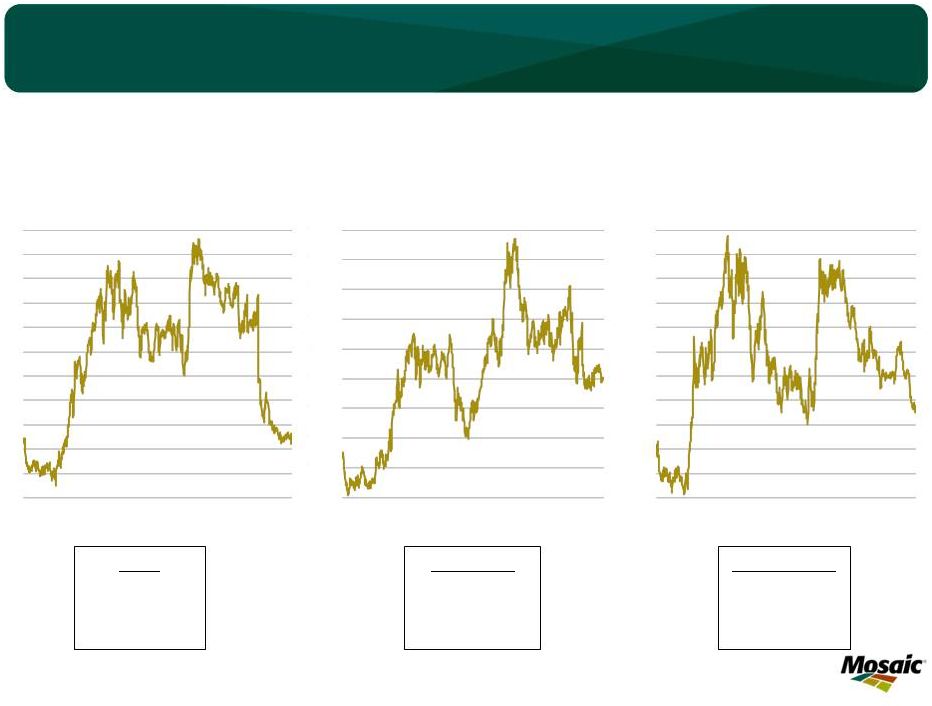 A different question
this year 9
2012/13: How high to allocate the short crop to its highest valued uses?
2013/14: How low to unleash pent-up demand and dull supply growth?
HRW Wheat
2012/13: $8.20
Current: $6.26
2013/14: ????
Corn
2012/13: $6.79
Current: $4.33
2013/14: ????
Soybeans
2012/13: $14.74
Current: $13.04
2013/14: ????
3.0
3.5
4.0
4.5
5.0
5.5
6.0
6.5
7.0
7.5
8.0
8.5
Jan-10
Jan-11
Jan-12
Jan-13
Jan-14
$ BU
Corn
Daily Close of Nearby Futures Contract
Source: CBOT
9.0
10.0
11.0
12.0
13.0
14.0
15.0
16.0
17.0
18.0
Jan-10
Jan-11
Jan-12
Jan-13
Jan-14
$ BU
Soybean Price
Daily Close of Nearby Futures Contract
Source: CBOT
4.5
5.0
5.5
6.0
6.5
7.0
7.5
8.0
8.5
9.0
9.5
10.0
Jan-10
Jan-11
Jan-12
Jan-13
Jan-14
$ BU
HRW Wheat Price
Daily Close of Nearby Futures Contract
Source: KCBOT |
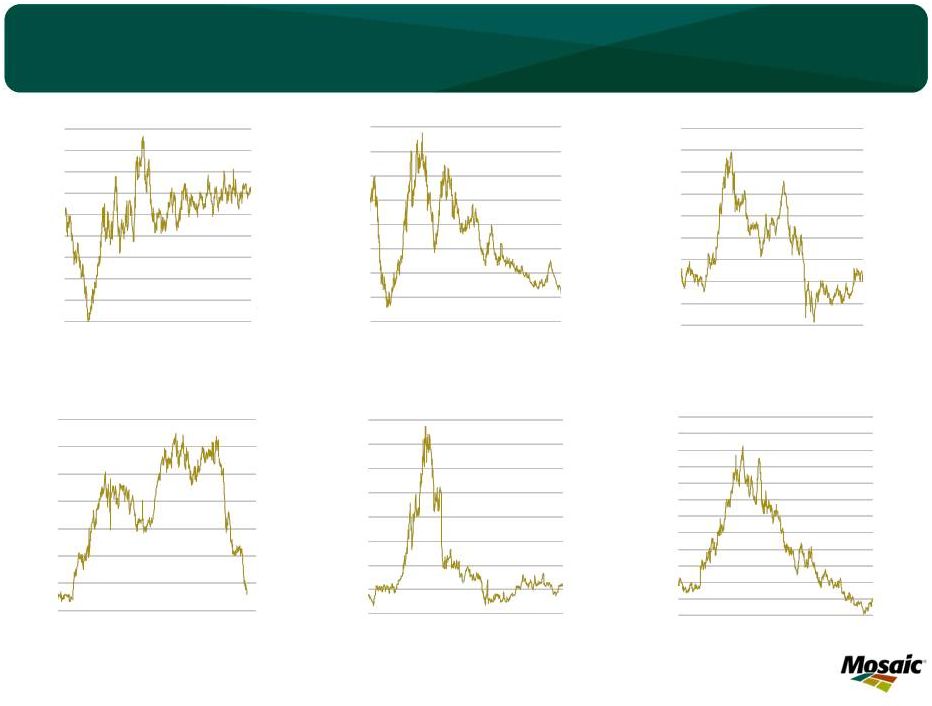 Other agricultural
commodity prices also are lower 10
9.5
10.5
11.5
12.5
13.5
14.5
15.5
16.5
17.5
18.5
Jan-10
Jan-11
Jan-12
Jan-13
Jan-14
CTS/LB
Rice (#2) Price
Daily Close of Nearby Futures Contract
Source: CME
12
15
18
21
24
27
30
33
36
Jan-10
Jan-11
Jan-12
Jan-13
Jan-14
CTS/LB
Sugar (#11) Price
Daily Close of Nearby Futures Contract
Source: ICE
2000
2250
2500
2750
3000
3250
3500
3750
4000
4250
Jan-10
Jan-11
Jan-12
Jan-13
Jan-14
RM/
Tonne
Palm Oil Price
Daily Close of Nearby Futures Contract
Source: Kuala Lumpur Exchange
60
80
100
120
140
160
180
200
220
Jan-10
Jan-11
Jan-12
Jan-13
Jan-14
CTS/LB
Cotton Price
Daily Close of Nearby Futures Contract
Source: ICE
100
120
140
160
180
200
220
240
260
280
300
320
340
Jan-10
Jan-11
Jan-12
Jan-13
Jan-14
CTS/LB
Coffee Price
Daily Close of Nearby Futures Contract
Source: ICE
350
400
450
500
550
600
650
700
Jan-10
Jan-11
Jan-12
Jan-13
Jan-14
C$/MT
Canola
Daily Close Cash Price
Source: WCE |
 Markets sending weaker
signals this year 11
3.50
4.00
4.50
5.00
5.50
6.00
6.50
7.00
7.50
8.00
J
A
S
O
N
D
J
F
M
A
M
J
US$ BU
New Crop Corn Prices
Daily Close of the New Crop Option Jul 1 to Jun 30
2008
2012
2013
2014
Source: CME
8.0
9.0
10.0
11.0
12.0
13.0
14.0
15.0
16.0
17.0
J
A
S
O
N
D
J
F
M
A
M
J
US$ BU
New Crop Soybean Prices
Daily Close of the New Crop Option Jul 1 to Jun 30
2008
2012
2013
2014
Source: CME
1.9
2.0
2.1
2.2
2.3
2.4
2.5
2.6
2.7
Jul-13
Aug-13
Sep-13
Oct-13
Nov-13
Dec-13
Jan-14
Close of New Crop Futures Soybean:Corn Ratio
2013
2014
Source: CME
4.00
5.00
6.00
7.00
8.00
9.00
10.00
11.00
12.00
13.00
J
A
S
O
N
D
J
F
M
A
M
J
US$ BU
New Crop Hard Red Winter Wheat Prices
Daily Close of the New Crop Option Jul 1 to Jun 30
2008
2012
2013
2014
Source: CME |
 All eyes on the corn
market 12
The USDA’s January 10 reports delivered good news for
the crop input supply industry. Lower projected U.S.
production and inventories as well as a bump in use
caused a sharp rally in corn prices and eased fears that
corn could drop to less than $4 bu heading into the
spring planting season.
However, world and U.S. corn inventories still are
projected to increase sharply due to the bumper U.S.
crop as well as record crops in other parts of the world
such as Brazil. Market is expected to closely watch
South American crop progress, U.S. Prospective
Plantings survey results and Chinese imports for future
direction.
0
7
14
21
28
35
42
49
56
63
70
0.0
0.5
1.0
1.5
2.0
2.5
3.0
3.5
4.0
4.5
5.0
70
73
76
79
82
85
88
91
94
97
00
03
06
09
12
Percent
Bil Bu
U.S. Corn Stocks
Stocks
Percent of Use
Source: USDA
5%
10%
15%
20%
25%
30%
35%
40%
45%
50%
0
25
50
75
100
125
150
175
200
225
70
73
76
79
82
85
88
91
94
97
00
03
06
09
12
Percent
Mil Tonnes
World Corn Stocks
Stocks
Percent of Use
Source: USDA
0
2
4
6
8
10
12
14
70
74
78
82
86
90
94
98
02
06
10
Bil Bu
U.S. Corn Use
Exports
Feed and Residual
Food & Industrial
Source: USDA |
 Impact of a lower
ethanol RFS is more psychological than economic at this point
13
The ethanol blending mandate was
scheduled to increase to 14.4
billion gallons in 2014, but the EPA
has proposed to lower the RFS to
13.01 billion gallons in order to
align it more closely with the E10
blend wall (current U.S. gasoline
demand is about 133 billion
gallons).
The 1.3 billion gallon decline is
equal to about 465 million bushels
of corn or almost 3 million
harvested acres. However,
ethanol production never would
have increased by this amount due
to the E10 blend wall. The change
likely will have a much greater
psychological impact than
fundamental impact on the corn
market.
EISA 2007 RFS2 & Proposed Adjustments
EPAct
Total
Advanced Biofuel
Conventional
2005
Renewable
Total
or Total Less
Year
RFS1
Fuel
Advanced
Cellulosic
Advanced
2006
4.00
na
na
na
na
na
2007
4.70
na
na
na
na
na
2008
5.40
9.00
na
na
na
9.00
2009
6.10
11.10
0.60
na
0.33
10.50
2010
6.80
12.95
0.95
0.01
0.82
12.00
2011
7.40
13.95
1.35
0.01
0.80
12.60
2012
7.50
15.20
2.00
0.09
1.00
13.20
2013
tbd
16.55
2.75
0.14
1.28
13.80
2014F
tbd
15.21
2.20
0.17
1.28
13.01
2015F
tbd
20.50
5.50
3.00
tbd
15.00
2016F
tbd
22.25
7.25
4.25
tbd
15.00
2017F
tbd
24.00
9.00
5.50
tbd
15.00
2018F
tbd
26.00
11.00
7.00
tbd
15.00
2019F
tbd
28.00
13.00
8.50
tbd
15.00
2020F
tbd
30.00
15.00
10.50
tbd
15.00
2021F
tbd
33.00
18.00
13.50
tbd
15.00
2022F
tbd
36.00
21.00
16.00
tbd
15.00
Source: Energy Policy Act of 2005 (EPACT 2005) and Energy Independence and Security Act of 2007
(EISA 2007), EPA-420-F-10-007, and Mosaic estimate.
Biomass-
Based Diesel |
 Fewer U.S. corn acres
are needed in 2014/15 -- if
yield equals trend and demand remains at high levels
14
14/15 Scenarios
(mil bu)
05/06
06/07
07/08
08/09
09/10
10/11
11/12
12/13
13/14F
#1
#2
#3
Acreage and Yield
Planted (mil acres)
81.8
78.3
93.5
86.0
86.4
88.2
91.9
97.2
95.4
95.0
91.0
87.6
Harvested (mil acres)
75.1
70.6
86.5
78.6
79.5
81.4
84.0
87.4
87.7
86.9
83.3
80.2
Yield (bu/acre)
147.9
149.1
150.7
153.9
164.7
152.8
147.2
123.4
158.8
165.7
165.7
165.7
Harvested Ratio (%)
91.9%
90.2%
92.5%
91.4%
92.0%
92.4%
91.4%
89.9%
91.9%
91.5%
91.5%
91.5%
Supply
Beginning Stocks
2,114
1,967
1,304
1,624
1,673
1,708
1,128
989
821
1,631
1,631
1,631
Production
11,112
10,531
13,038
12,092
13,092
12,447
12,360
10,780
13,925
14,403
13,797
13,285
Imports
9
12
20
14
8
28
29
162
35
15
15
15
Total
13,235
12,510
14,361
13,729
14,773
14,182
13,517
11,932
14,781
16,050
15,443
14,931
Use
Feed & Residual
6,115
5,540
5,858
5,182
5,126
4,799
4,557
4,335
5,300
5,300
5,300
5,300
FIS
3,019
3,541
4,442
5,025
5,961
6,425
6,428
6,044
6,400
6,300
6,300
6,300
Ethanol for Fuel
1,603
2,119
3,049
3,709
4,591
5,019
5,011
4,650
4,900
4,800
4,800
4,800
Exports
2,134
2,125
2,437
1,849
1,979
1,830
1,543
731
1,450
1,700
1,700
1,700
Total
11,268
11,207
12,737
12,056
13,066
13,055
12,528
11,110
13,150
13,300
13,300
13,300
Ending Stocks
1,967
1,304
1,624
1,673
1,708
1,128
989
821
1,631
2,750
2,143
1,631
Stocks as % of Use
17.5%
11.6%
12.8%
13.9%
13.1%
8.6%
7.9%
7.4%
12.4%
20.7%
16.1%
12.3%
USDA |
 A large rebound in
global soybean stocks largely due to record South American production
15
0%
5%
10%
15%
20%
25%
30%
35%
0
10
20
30
40
50
60
70
80
70
73
76
79
82
85
88
91
94
97
00
03
06
09
12
Percent
Mil Tonnes
World Soybean Stocks
Source: USDA
0
5
10
15
20
25
30
0
100
200
300
400
500
600
70
73
76
79
82
85
88
91
94
97
00
03
06
09
12
Percent
Mil Bu
U.S. Soybean Stocks
Source: USDA
0
20
40
60
80
100
120
140
160
70
73
76
79
82
85
88
91
94
97
00
03
06
09
12
Mil Tonnes
South American Soybean Production
Brazil
Argentina
Paraguay
Source: USDA
Stocks
Percent of Use
Mil Bu
Percent of Use |
 Oh Canada! What
a wheat (and canola) crop 16
12%
15%
18%
21%
24%
27%
30%
33%
36%
39%
0
25
50
75
100
125
150
175
200
225
70
73
76
79
82
85
88
91
94
97
00
03
06
09
12
Percent
Mil Tonnes
World Wheat Stocks
Stocks
Percent of Use
Source: USDA
0
10
20
30
40
50
60
70
80
90
100
0.0
0.2
0.4
0.6
0.8
1.0
1.2
1.4
1.6
1.8
2.0
70
73
76
79
82
85
88
91
94
97
00
03
06
09
12
Percent
Bil Bu
U.S. Wheat Stocks
Bil Bu
Percent of Use
Source: USDA
0
5
10
15
20
25
30
35
40
70
73
76
79
82
85
88
91
94
97
00
03
06
09
12
Mil Tonnes
Canada Wheat Production
Source: USDA
0
2
4
6
8
10
12
14
16
18
20
70
73
76
79
82
85
88
91
94
97
00
03
Mil Tonnes
Canada Rapeseed Production
Source: USDA
06
09
12 |
 A wide range of
potential outcomes in 2014/15, but likely case illustrates the challenge of the food story
17
607
580
494
407
470
463
427
439
515
571
550
535
515
570
350
400
450
500
550
600
650
00
01
02
03
04
05
06
07
08
09
10
11
12
13E
14F
Mil Tonnes
World Grain & Oilseed Stocks
Historical
2014/15 Range
2014/15 Medium Scenario
Source: USDA and Mosaic
2014/15 Grain and Oilseed Scenario Assumptions
Low
Medium
High
Harvested Area Change
-0.50%
0.00%
0.50%
Yield Deviation from Trend *
Largest Negative
0.00
Largest Positive
Demand Growth
2.0%
2.5%
3.0%
* Trend yield for 2000/01 to 2012/13 crop years. |
 Food story still
intact in the long run 18
1,000
1,500
2,000
2,500
3,000
3,500
80
85
90
95
00
05
10
20F
30F
Mil Tonnes
Source: USDA and Mosaic
World Grain and Oilseed Use
Actual for Biofuels
Actual
Forecast for Biofuels
Forecast
1.75
2.00
2.25
2.50
2.75
3.00
3.25
3.50
3.75
775
800
825
850
875
900
925
950
975
80
85
90
95
00
05
10
20F
30F
MT Ha
Mil Ha
World Harvested Area and Average Yield
Actual Area
Forecast Area
Actual Yield
Required Yield
1980-10 Yield Trend |
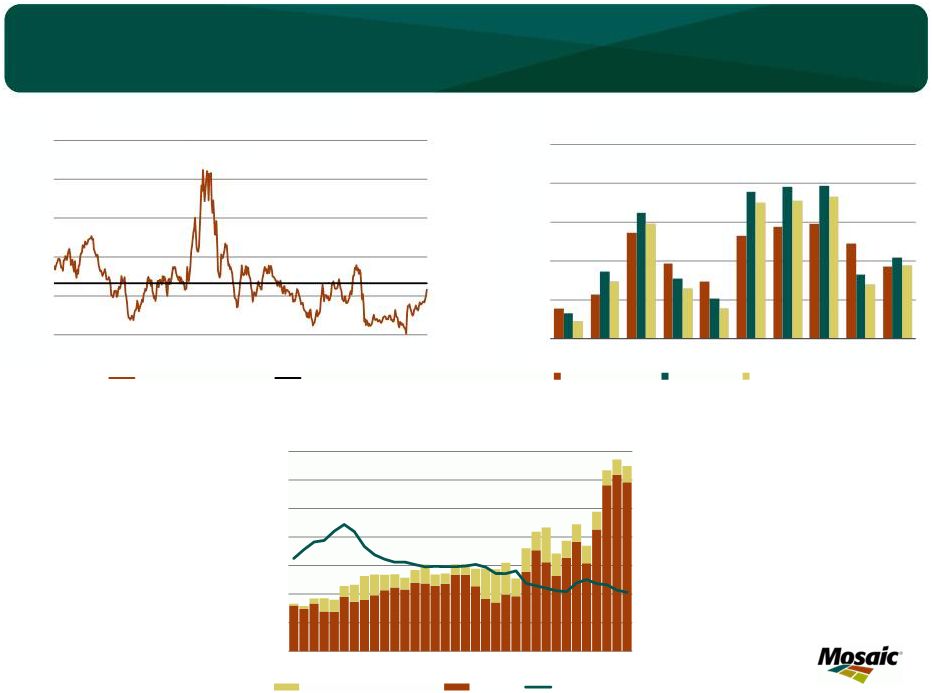 Less robust but still
constructive demand drivers 19
0.50
0.75
1.00
1.25
1.50
1.75
05
06
07
08
09
10
11
12
13
14
Plant Nutrient Affordability
Plant Nutrient Price Index / Crop Price Index
Affordability Metric
Average
Source: Weekly Price Publications, CME,
USDA, AAPFCO, Mosaic
0%
5%
10%
15%
20%
25%
30%
35%
0
20
40
60
80
100
120
140
80
83
86
89
92
95
98
01
04
07
10
13F
Debt:Asset
Ratio
Bil $
U.S. Net Cash Farm Income
Government Payments
Debt: Asset Ratio
Source: USDA
$0
$200
$400
$600
$800
$1,000
05/06
06/07
07/08
08/09
09/10
10/11
11/12
12/13
13/14F
14/15F
$ Acre
Source: Iowa State University, USDA and Mosaic
Estimated Return After Variable Cost
for a U.S. Midwest High Yield Farm Operation
Soybeans
Corn
Corn Following Corn
Market |
 Phosphate Situation and Outlook |
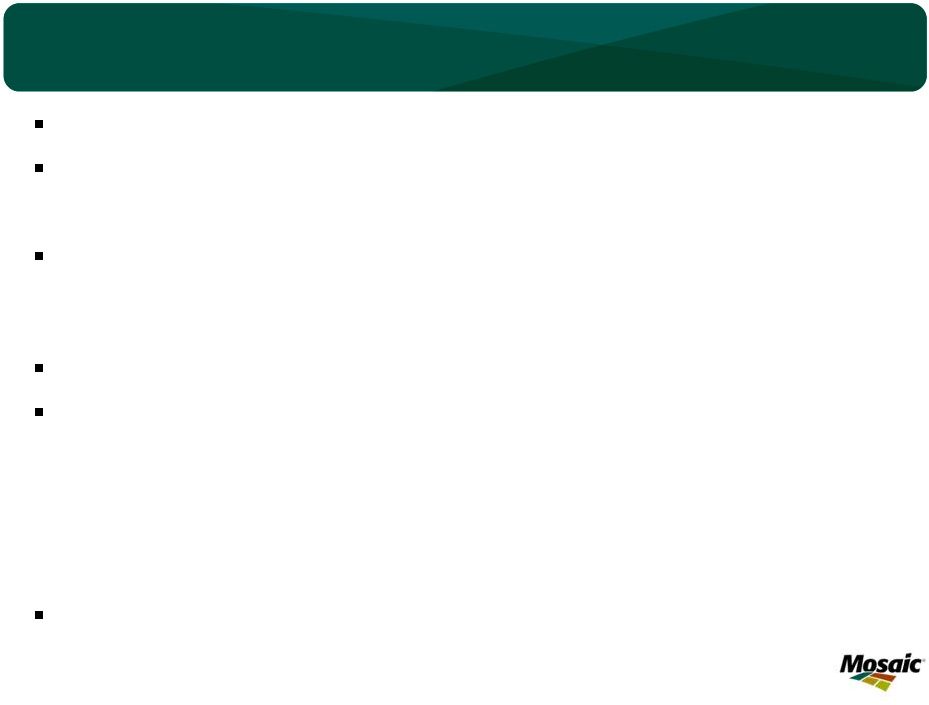 Key
Features and Take Aways Prices have rallied ~$75-$100 tonne since the end
of November Positive demand prospects
–
Less robust but still constructive demand drivers
–
Record global shipments and a rebound in trade in 2014
Lean channel inventories worldwide (China the notable
exception) –
Limited livin’
off the pipeline this year
–
The knife has hit the floor and buyers are picking it up (i.e.
positioning product for the upcoming season) –
India case study: a rebound in shipments and imports are expected beginning
in Q2 China export policies/economics likely will set a price ceiling
Still several uncertainties and caution flags
–
The direction of agricultural commodity prices
–
Indian 2014/15 phosphate subsidy
–
New supplies
•
Continued ramp-up of Ma’aden production and additional finished product
and possibly acid capacity in Morocco •
Indian JV acid plants in Tunisia (Tifert) and Jordan (Jifco)
–
Raw materials costs (sulphur has roared higher over the past couple of
months) –
Macroeconomic backdrop and impact on exchange rates (especially the
Indian rupee) Bottom line: Tight near term with China economics
likely setting the ceiling later in 2014
21 |
 Prices have rallied
~$70-$100 since the end of November
22
100
200
300
400
500
600
05
06
07
08
09
10
11
12
13
14
$ ST
Weekly DAP Prices
Central Florida Rail
Source: Green Markets
100
200
300
400
500
600
05
06
07
08
09
10
11
12
13
14
$ ST
Weekly DAP Prices
NOLA Barge
Source: Green Markets
200
300
400
500
600
700
05
06
07
08
09
10
11
12
13
14
$ MT
Weekly DAP Prices
fob Tampa
Source: Fertecon |
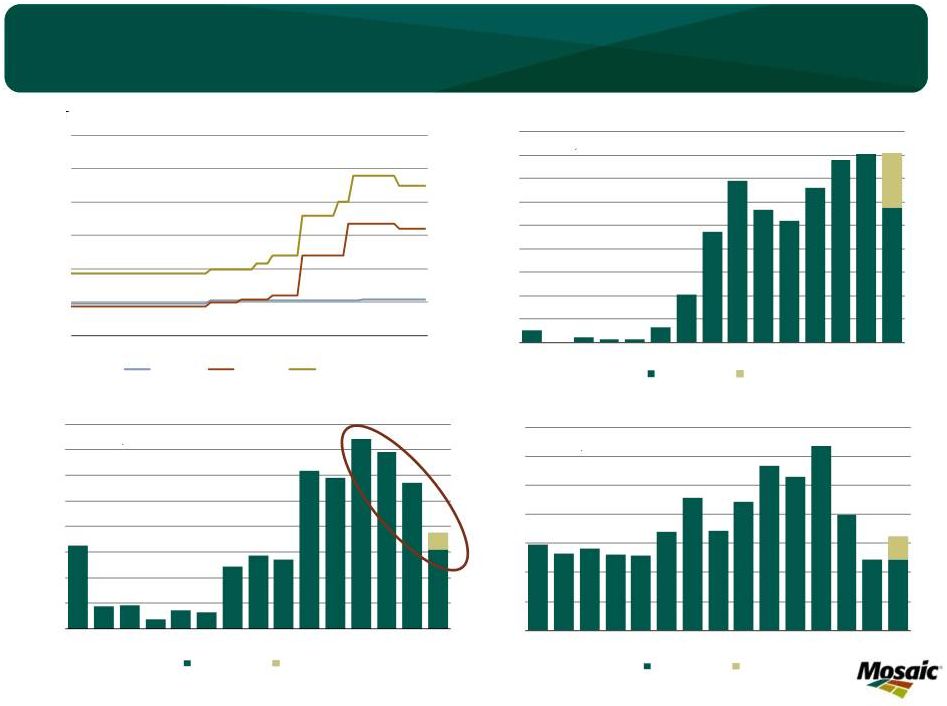 23
0
5,000
10,000
15,000
20,000
25,000
30,000
2008
2009
2010
2011
2012
2013
India Retail Plant Nutrient Prices
Urea
MOP
DAP
INR / MT
Source: FAI, Mosaic
0.0
1.0
2.0
3.0
4.0
5.0
6.0
7.0
8.0
00
01
02
03
04
05
06
07
08
09
10
11
12
13
14
YTD
Mil Tonnes
India DAP Imports
Actual
Forecast
Source: FAI, Mosaic
Fertilizer Year Ending March 31
0.0
1.0
2.0
3.0
4.0
5.0
6.0
7.0
8.0
9.0
00
01
02
03
04
05
06
07
08
09
10
11
12
13
14
YTD
Mil Tonnes
India Urea Imports
Actual
Forecast
Source: FAI, Mosaic
Fertilizer Year Ending March 31
0.0
1.0
2.0
3.0
4.0
5.0
6.0
7.0
00
01
02
03
04
05
06
07
08
09
10
11
12
13
14
YTD
Mil Tonnes
India MOP Imports
Actual
Forecast
Source: FAI, Mosaic
Fertilizer Year Ending March 31
What drove the decline in global DAP pricing?
Collapse of Indian Import Demand |
 Livin’
off the Pipeline: India DAP Example
24
Million Tonnes DAP
2013/14E
2014/15
Producer/Importer Beginning Inventory
1.45
Production
3.67
Imports
3.90
Producer/Importer Sales to Retailer Dealers
7.82
Retail Dealer Sales to Farmers
9.82
Retail Inventory Change
-2.00
Producer/Importer Ending Inventory
1.20
Producer/Importer Inventory Change
-0.25
Total Pipeline Inventory Change
-2.25
Our Delhi team estimates that DAP demand by farmers remains strong due to an
outstanding monsoon and profitable farm economics. The government has
raised minimum support prices for major crops, retail urea prices remain
stable at the extremely low level of $80-$85 per tonne, and retail P&K prices, while up sharply from pre-
reform
levels,
have
declined
modestly
in
2013/14.
As
a
result,
retail
dealer
DAP
sales
to
farmers
are
projected
to
total 9.8 million tonnes this fertilizer year.
Producer and importer sales, however, are projected to drop to 7.8 million tonnes,
implying a retail inventory decline of 2.0 million tonnes. In
addition, producer/importer inventories also are projected to decline 250,000
tonnes in 2013/14. |
 Which Led to a Tale of
Two Hemispheres 25
Americas –
Strong Demand in 2013
and Outstanding Prospects Remain
0.0
0.2
0.4
0.6
0.8
1.0
1.2
Jul
Aug
Sep
Oct
Nov
Dec
Jan
Feb
Mar
Apr
May
Jun
Mil Tons
U.S. DAP and MAP/MES Shipments
MIN MAX Range (05/06-11/12)
2012/13
7-Yr Olympic Avg
Source: TFI and Mosaic
0.0
0.2
0.4
0.6
0.8
1.0
1.2
Jul
Aug
Sep
Oct
Nov
Dec
Jan
Feb
Mar
Apr
May
Jun
Mil Tons
U.S. DAP and MAP/MES Shipments
MIN MAX Range (06/07-12/13)
2013/14
7-Yr Olympic Avg
Source: TFI and Mosaic
3.0
4.5
6.0
7.5
9.0
10.5
12.0
3.0
3.5
4.0
4.5
5.0
5.5
6.0
95
97
99
01
03
05
07
09
11
13
15F
Mil Tons
Product
Mil Tons
P
2
O
5
NA Phosphate Use and
DAP/MAP/MES/TSP Shipments
Phosphate Use
Phosphate Product Shipments
Source: AAPFCO, TFI, IFA and Mosaic
Fertilizer Year Ending June 30 |
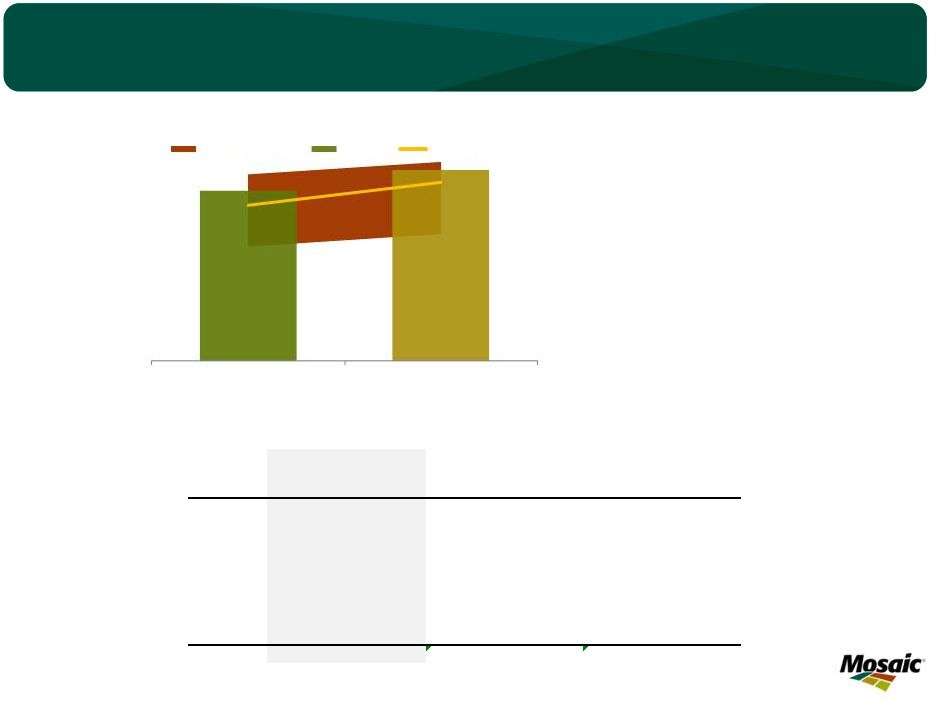 Actual
Forecast
Shipments
13/14
Shipments
13/14
Shipments
13/14
Jun-May
% Chg
Jun-Nov
% Chg
Dec-May
% Chg.
2005/06
8,218
18%
3,726
22%
4,492
14%
2006/07
8,485
14%
3,600
27%
4,885
5%
2007/08
9,507
2%
4,639
-2%
4,868
5%
2008/09
6,415
51%
3,040
50%
3,375
51%
2009/10
8,078
20%
3,573
27%
4,505
13%
2010/11
9,673
0%
4,355
5%
5,317
-4%
2011/12
9,042
7%
4,556
0%
4,486
14%
2012/13
10,076
-4%
4,983
-9%
5,094
0%
2013/14F
9,668
n/a
4,555
n/a
5,113
n/a
7-yr Oly Avg
8,957
8%
4,145
10%
4,768
7%
1000 tons of DAP, MAP, TSP, MES
North American Domestic Phosphate Shipments
Which Led to a Tale of Two Hemispheres
26
Americas
–
Strong
Demand
in
2013
and Outstanding Prospects Remain
0.0
1.0
2.0
3.0
4.0
5.0
6.0
Jun-Nov 2013
Dec-May 2014 F
Mil Tons
North American Phosphate Product Shipments
7-Yr Min-Max Range
2013/14
7-Yr Olympic Average |
 Which Led to a Tale of
Two Hemispheres 27
Americas
–
Strong
Demand
in
2013
and Outstanding Prospects Remain
0
100
200
300
400
500
600
700
800
Jan
Feb
Mar
Apr
May
Jun
Jul
Aug
Sep
Oct
Nov
Dec
1000 Tonnes
Brazil DAP/MAP/TSP Imports
Min/Max Range (2008-2012)
2013 Fcst
7-Yr Olympic Average
Source: Brazil Mosaic
0.0
0.5
1.0
1.5
2.0
2.5
3.0
3.5
4.0
4.5
5.0
00
01
02
03
04
05
06
07
08
09
10
11
12
13F
14F
MMT
Brazil DAP/MAP/TSP Imports
DAP
MAP/MES
TSP
Souce:
Fertecon, ANDA, Mosaic |
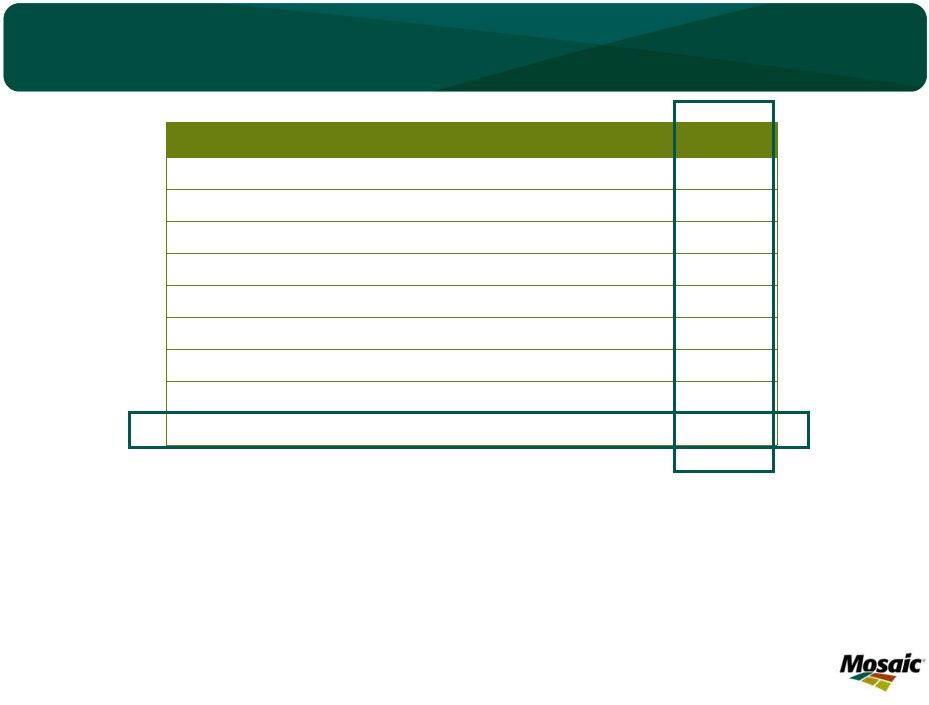 India DAP Pipeline Example: 2014/15
28
Million Tonnes DAP
2013/14E
2014/15F
Producer/Importer Beginning Inventory
1.45
1.20
Production
3.67
3.80
Imports
3.90
5.70
Producer/Importer Sales to Retailer Dealers
7.82
9.70
Retail Dealer Sales to Farmers
9.82
10.30
Retail Inventory Change
-2.00
-0.60
Producer/Importer Ending Inventory
1.20
1.00
Producer/Importer Inventory Change
-0.25
-0.20
Total Pipeline Inventory Change
-2.25
-0.85
India will have a limited ability to further draw down pipeline inventories to meet
farmer demand, and we expect marked improvement in imports even under the
assumption that they can flush the pipeline further (to the tune of nearly 1
million tonnes). |
 Will Likely Remain a
Tale of Two Hemispheres, but the Beginning of a Recovery in India
29
The exchange rate remains a risk to the
forecast, as depreciation of the Rupee
was a primary driver of lower Indian
imports in 2013.
Changes to the subsidy regime could
also play a role, with election year
politics another wildcard.
1.2
1.8
1.3
3.3
3.6
5.5
3.8
4.2
2.6
3.4
1.2
1.0
1.5
3.0
2.2
2.1
3.4
1.5
1.2
2.3
0.0
1.0
2.0
3.0
4.0
5.0
6.0
7.0
8.0
06
07
08
09
10
11
12
13
14F
15F
Mil Tonnes
Fertilizer Year Ending March 31
India DAP Imports
Kariff (Apr 1-Sep 30)
Rabi (Oct 1-Mar 31)
Source: FAI
and Mosaic India
38
43
48
53
58
63
68
A-03
N-04
F-06
M-07
A-08
N-09
F-11
M-12
A-13
N-14
F-16
INR/US$
India Forex
November Fcst
December Fcst
Source: IHS Global
0
200
400
600
800
1,000
1,200
1,400
1,600
Apr
May
Jun
Jul
Aug
Sep
Oct
Nov
Dec
Jan
Feb
Mar
1000 Tonnes
India DAP Imports
Source: FAI |
 No More Living off the
Pipeline, so: Record Shipments and a Rebound in Import Demand
30
51
47
53
59
62
63
63-64
64-66
30
35
40
45
50
55
60
65
70
00
01
02
03
04
05
06
07
08
09
10
11
12
13F
14F
Global Phosphate Shipments
Likely Scenario
MMT Product
DAP/MAP/MES/TSP
Source: Fertecon
& Mosaic
0
5
10
15
20
25
00
01
02
03
04
05
06
07
08
09
10
11
12
13F
14F
MMT
Source: CRU/FRC and Mosaic
Global Phosphate Import Demand
Likely Scenario excluding China
Asia and Oceania
Latin America
Europe
Mideast
Africa
North America
FSU |
 2014 Wildcard:
China’s exports likely will cap the recent rally in DAP prices later in 2014
31
Chinese phosphates exports declined in 2013 due to a
combination of lower Indian imports and profitability issues
during a period of falling prices.
Export tariffs have been set for 2014. While lower than last
year, the tariff appears to remain prohibitive during the
‘high tax’
season.
High-Tax
0.0
1.0
2.0
3.0
4.0
5.0
6.0
7.0
95
97
99
01
03
05
07
09
11
13
YTD
Mil Tonnes
China DAP/MAP/TSP Exports
Actual
Forecast
Source: Fertecon, China Customs, Mosaic
($160)
($140)
($120)
($100)
($80)
($60)
($40)
($20)
$0
$20
$40
$60
$300
$325
$350
$375
$400
$425
$450
$475
$500
$ Tonne
DAP CNF India
Chinese FOB Gross Export Margin to India
Integrated
Non-Integrated
Source: Mosaic
Product
Urea
DAP/MAP
TSP/SSP
MOP/SOP
NPKs
NPs
PKs
Amm Chloride
CNY 600/tonne
30%
CNY 50/tonne
15% + CNY 50/tonne
16 May-15 Oct
1 Jan-15 May / 16 Oct-31 Dec
5%
5%
16 May-15 Oct
1 Jan-15 May / 16 Oct-31 Dec
5%
CNY 50/tonne
15% + CNY 50/tonne
CNY 40/tonne
15% + CNY 40/tonne
Jul-Oct
Jan-Jun / Nov-Dec
Chinese Export Tariffs for 2014
Off Season
Peak Season |
 Potash Situation and Outlook |
 Key
Features and Take Aways Prices likely at or near a floor
Expected demand rebound in response to lower prices in 2014
–
Less robust but still constructive demand drivers
–
Rebound led by the “Big Six”
Large producer but lean channel inventories worldwide
Trigger event required to get product moving down the pipeline
–
2014 FH China contract settlement (following recently announced
North American fill prices) –
More clarity/certainty about agricultural commodity prices following the January 10
USDA reports –
BPC 2.0: potential significant impact on psychology/sentiment but not on
market fundamentals Still several uncertainties and caution flags
–
Agricultural commodity prices
•
Size of the Southern Hemisphere crop
•
2014 U.S. Prospective Plantings report (March 31)
•
China corn imports (resolution to the GMO issue)
•
Instincts of the speculative herd
–
Indian 2014/15 potash subsidy
–
Impact of two Canpotex proving runs
–
Macroeconomic backdrop (especially impact on exchange
rates) Bottom line: stable near term price outlook with modest upside
risk later in 2014 33 |
 Prices likely at or near a bottom
34
100
200
300
400
500
600
700
100
200
300
400
500
600
700
00
01
02
03
04
05
06
07
08
09
10
11
12
13
14
$ MT c&f
Brazil
$ ST fob
Midwest
Terminal
Blend Grade Muriate of Potash Prices
fob U.S. Midwest Warehouse
c&f Brazil
Source: Green Markets and ICIS |
 Demand rebound in
response to lower prices in 2014 35
54
50
30
53
55
51
54-55
-59
25
30
35
40
45
50
55
60
00
01
02
03
04
05
06
07
08
09
10
11
12
13E
14F
Global Potash Shipments
Likely Scenario
MMT Product
KCl
Source: Fertecon
and Mosaic
57
0
5
10
15
20
25
30
35
40
00
01
02
03
04
05
06
07
08
09
10
11
12
13E
14F
MMT KCl
Global Potash Import Demand
Likely Scenario excluding Canada => U.S.
Asia/Oceania
Latin America
Europe/FSU
North America
Other
Source: Fertecon
and Mosaic |
 36
Rebound led by the “Big Six”
0.0
1.0
2.0
3.0
4.0
5.0
6.0
7.0
8.0
9.0
00
01
02
03
04
05
06
07
08
09
10
11
12
13E
14F
MMT
Brazil MOP Import Demand
Source: Fertecon and Mosaic
0.0
1.0
2.0
3.0
4.0
5.0
6.0
7.0
8.0
9.0
10.0
00
01
02
03
04
05
06
07
08
09
10
11
12
13E
14F
MMT
China Net MOP Import Demand
Source: Fertecon and Mosaic
0.0
1.0
2.0
3.0
4.0
5.0
6.0
7.0
00
01
02
03
04
05
06
07
08
09
10
11
12
13E
14F
MMT
India MOP Import Demand
Source: Fertecon and Mosaic
0.0
1.0
2.0
3.0
4.0
5.0
6.0
00
01
02
03
04
05
06
07
08
09
10
11
12
13E
14F
MMT
Indonesia/Malaysia MOP Import Demand
Source: Fertecon and Mosaic |
 Large expected rebound
in NA exports in response 37
North American MOP Exports
Mil Tons
KCl
Source: IPNI and Mosaic
0.0
0.2
0.4
0.6
0.8
1.0
1.2
1.4
1.6
Jul
Aug
Sep
Oct
Nov
Dec
Jan
Feb
Mar
Apr
May
Jun
MIN MAX Range (05/06-11/12)
2012/13
7-Yr Olympic Avg
0
2
4
6
8
10
12
14
96
97
98
99
00
01
02
03
04
05
06
07
08
09
10
11
12
13
14F15F
Mil Tons
KCl
North American MOP Exports
U.S.
Canada
Source: IPNI and Mosaic
Fertilizer Year Ending June 30
Mil Tons
KCl
North American MOP Exports
Source: IPNI and Mosaic
0.0
0.2
0.4
0.6
0.8
1.0
1.2
1.4
1.6
Jul
Aug
Sep
Oct
Nov
Dec
Jan
Feb
Mar
Apr
May
Jun
MIN MAX Range (06/07-12/13)
2013/14
7-Yr Olympic Avg
0.0
0.2
0.4
0.6
0.8
1.0
1.2
1.4
1.6
Jul
2008/09
Jan
Jul
2009/10
Jan
Jul
2010/11
Jan
Jul
2011/12
Jan
Jul
2012/13
Jan
Jul
2013/14
Jan
Mil Tonnes KCl
North America MOP Exports
Source: IPNI |
 Actual
Forecast
Shipments
13/14
Shipments
13/14
Shipments
13/14
Jun-May
% Chg
Jun-Nov
% Chg
Dec-May
% Chg.
2005/06
9,050
10%
4,355
7%
4,695
13%
2006/07
11,205
-11%
4,376
6%
6,829
-22%
2007/08
10,653
-7%
4,698
-1%
5,955
-11%
2008/09
5,764
73%
3,953
17%
1,811
193%
2009/10
7,671
30%
2,112
120%
5,558
-5%
2010/11
10,681
-7%
4,701
-1%
5,980
-11%
2011/12
8,667
15%
4,577
1%
4,090
30%
2012/13
10,092
-1%
4,867
-5%
5,225
1%
2013/14F
9,945
n/a
4,645
n/a
5,300
n/a
7-yr Oly Avg
9,553
4%
4,461
4%
5,362
-1%
1000 tons of MOP
North American Domestic Muriate of Potash Shipments
Rebound led by the “Big
Six”
including
high and
steady NA shipments
38
5
6
7
8
9
10
11
12
13
0
1
2
3
4
5
6
7
8
96
97
98
99
00
01
02
03
04
05
06
07
08
09
10
11
12
13
14F15F
Mil Tons
KCl
Mil Tons
K
2
O
North American Potash Use and MOP Shipments
Ag Use (L)
Total Shipments (R)
Source: IPNI and Mosaic
Fertilizer Year Ending June 30
0.0
1.0
2.0
3.0
4.0
5.0
6.0
7.0
8.0
Jun-Nov 2013
Dec-May 2014 F
Mil Tons KCl
North American Potash Shipments
7-Yr Min-Max Range
2013/14
7-Yr Olympic Average |
 U.S. offshore imports
expected to drop in 2013/14 and rebound to average levels in 2014/15
39
0
50
100
150
200
250
Jul
2008/09
Jan
Jul
2009/10
Jan
Jul
2010/11
Jan
Jul
2011/12
Jan
Jul
2012/13
Jan
Jul
2013/14
Jan
1,000 Tonnes
KCl
U.S. MOP Offshore Imports
Source: U.S. Department of Commerce
U.S. trade data one month delayed
0.0
0.1
0.1
0.2
0.2
0.3
0.3
Jul
Aug
Sep
Oct
Nov
Dec
Jan
Feb
Mar
Apr
May
Jun
Mil Tons
KCl
North American MOP Imports
MIN MAX Range (06/07-12/13)
13/14 Fcst
7-Yr Oly Avg
Source: IPNI and Mosaic
0.0
0.2
0.4
0.6
0.8
1.0
1.2
1.4
1.6
1.8
96
97
98
99
00
01
02
03
04
05
06
07
08
09
10
11
12
13
14F15F
Mil Tons
KCl
North American MOP Imports
Source: IPNI, USDOC, and Mosaic
Fertilizer Year Ending June 30 |
 Large producer
but
lean
channel
inventories
–
need
a
trigger to get the ‘K pig moving through the python’
40
0.0
0.5
1.0
1.5
2.0
2.5
3.0
3.5
4.0
Jul
2008/09
Jan
Jul
2009/10
Jan
Jul
2010/11
Jan
Jul
2011/12
Jan
Jul
2012/13
Jan
Jul
2013/14
Jan
Mil Tonnes KCl
North America MOP Producer Stocks
Source: IPNI
0.0
0.5
1.0
1.5
2.0
2.5
3.0
3.5
4.0
4.5
Jul
Aug
Sep
Oct
Nov
Dec
Jan
Feb
Mar
Apr
May
Jun
Mil Tons
KCl
North American MOP Stocks
MIN MAX Range (06/07-12/13)
13/14
7-Yr Oly Avg
Source: IPNI and Mosaic |
 Factors to Watch and Handicap |
 Factors to Watch and Handicap
42
Agricultural Commodity Prices
–
South American crop progress
•
The market likely has baked in a record soybean crop but it could further weigh on
prices once it is in the bin (Feb/Mar) –
Energy, biofuels and livestock prices
•
But proposed changes to the U.S. RFS in 2014 likely will have only a limited impact
in the near term –
U.S. Prospective Plantings report on March 31
•
Less
corn
acreage
is
required
but
will
farmers
plant
too
much
if
2015
new
crop
is
$4.50+
and
it
is
an
early
spring?
–
China soybean (how large?) and corn (how low) imports
–
Macroeconomic developments and their impact on exchange rates
–
Instincts
of
the
large
speculative
herd
–
what
might
drive
them
in
or
spook
them
out? |
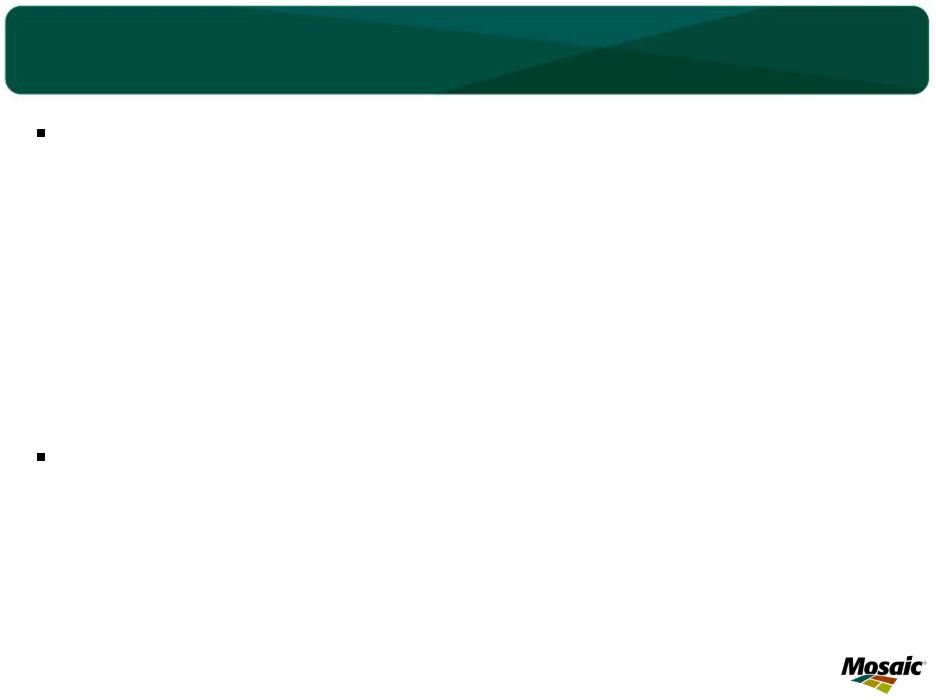 Factors to Watch and Handicap
43
Other P&K Fundamentals
–
Global pipeline and producer inventories
•
The
“P”
pig
is
moving
through
the
python
but
when
will
the
python
swallow
the
“K”
pig?
–
Developments in India
•
Plant nutrient subsidy rates (2014/15 budget tabled by February 28)
•
Settlement of P&K contracts
–
Developments in China
•
Settlement of K contract
•
Phosphate exports –
what volume at what price?
–
New P&K supplies in 2014
•
Continued ramp-up of Ma'aden production and commissioning of OCP granulation
and acid plants •
Indian JV plants in Tunisia (Tifert) and Jordan (Jifco)
•
Continued start-up of brownfield K projects and management of Canpotex proving
runs Triggers that could change sentiment
–
Settlement of large contracts in China and India
–
Agricultural commodity price breakout from current range
–
Unexpected supply disruption (e.g. mine/plant outage or transportation
glitch) –
Political or macroeconomic event |
 Market Outlook
Picking Up the Knife (and starting a fight?)
Mosaic AgCollege
Orlando, FL
January 14, 2014
Michael R. Rahm
Vice President
Market and Strategic Analysis
Andy Jung
Director
Market and Strategic Analysis
Thank You for Your Business! |
